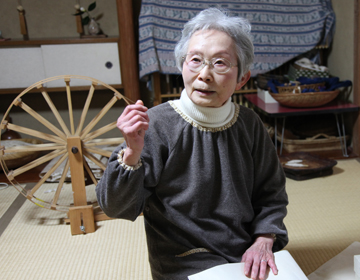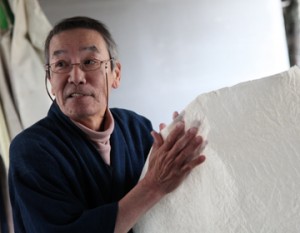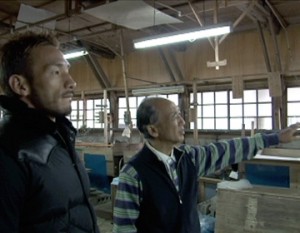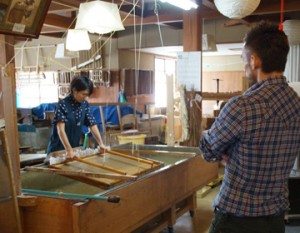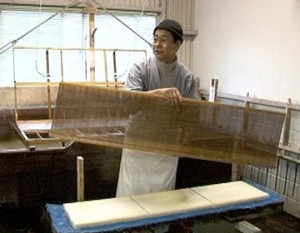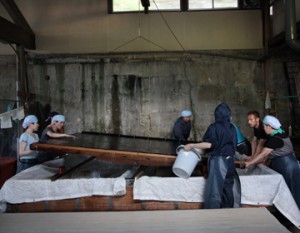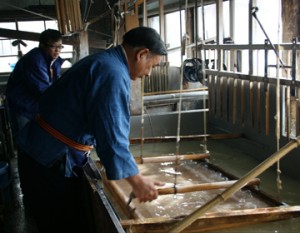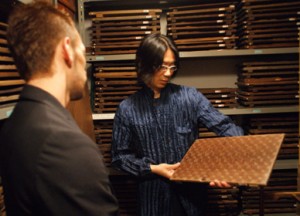Making thread from “washi”
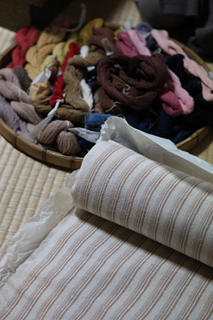
A paper cloth is, as the name suggests, cloth that’s made from paper. Thread is made from paper, and a fabric is woven from that thread. It is difficult to imagine how that is done, so we visited Sadako Sakurai, one of the leading artists in that domain, and had her demonstrate how it’s done.
”The really difficult part of paper cloth is spinning thin threads from paper. Since you are here, I will show you how I make the most difficult 2mm thread.” Sakurai folded four pieces of ”washi” so they should stand up and then cut them into 2 mm widths. Then she wet the pieces of paper and softened them in a rolling motion on a flat rock. Then, taking care to not tear the paper, she loosened the fiber and rolled them again. And that process was repeated again and again. ”See how it’s turned into thread?” All of a sudden the paper had turned into thread. Then she took them, broke them one by one with her fingers and then twisted them together to form a long thread. Then these threads were carefully twisted onto a spinner, and set on a form called ”kase”, and then it’s done.
The “washi” that makes paper cloth possible
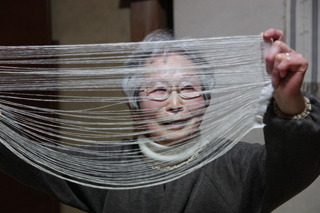
A special kind of ”washi” is required to make this paper cloth.
“I need good paper. It has to be good paper, otherwise the work will definitely fall apart before completion.” The paper needed to be thin and strong, made by a master craftsman from 100% mulberry trees. The only paper that was able to meet her exacting demands was the ”washi” made by the Nishinouchi rice paper master Kikuchi, she told us. “When making paper, fine silk needs to be spread on top of the guider so that it will come out with a fine texture.” She said she ordered the paper again and again until the ideal one was produced. There are only a few paper cloth artists left in Japan. For Sakurai, the restoration of the manufacturing process of paper cloth was the hardest part.
Starting from zero
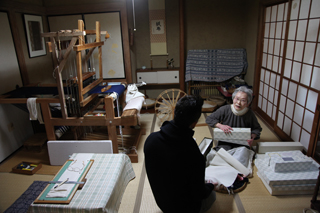
”My husband was the greatest helper. I mean after all, he is the one who suggested we restore Shiraishi paper cloth.” Sakurai saw Shiraishi paper cloth with her late husband in Miyagi Prefecture, and they were struck by its graceful beauty and decided that this technique had to be preserved. Since then, their researched together. Shiraishi cloth paper was made by samurais belonging to the Date clan, and presented to the Tokugawa shogunate. It was a highly protected family secret and references were few. With cooperation from Nobuhide Katakura of the Katakura family who inherited the tradition of Shiraishi paper cloth, they had to figure out how to make paper cloth from what little literature remained. After one year and 3 months of tedious efforts, they finally restored the paper moistening method that they had so much difficulty with. After further trials and error, they attempted to restore the various weaving methods of the paper cloth.
The beauty within paper cloth
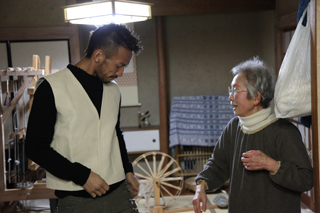
”These are the ultimate” she said as she showed us the textile which was woven with silk warp and paper weft. It was graceful and beautiful. The other one was a crepe textile. They had succeeded in restoring the technique for combining silk and paper cloth, by weaving strongly twisted weft. These were really the fruits of their zealous research and practice.
Before leaving, Nakata tried on a vest made from paper cloth. He somehow looked formal and stoic. Paper cloth maintains the characteristics of paper, and it dries fast and is cool in the summer, while being warm in the winter. Thus we re-discovered another quality about Japanese ”washi”, deepening our interest in them as well.



